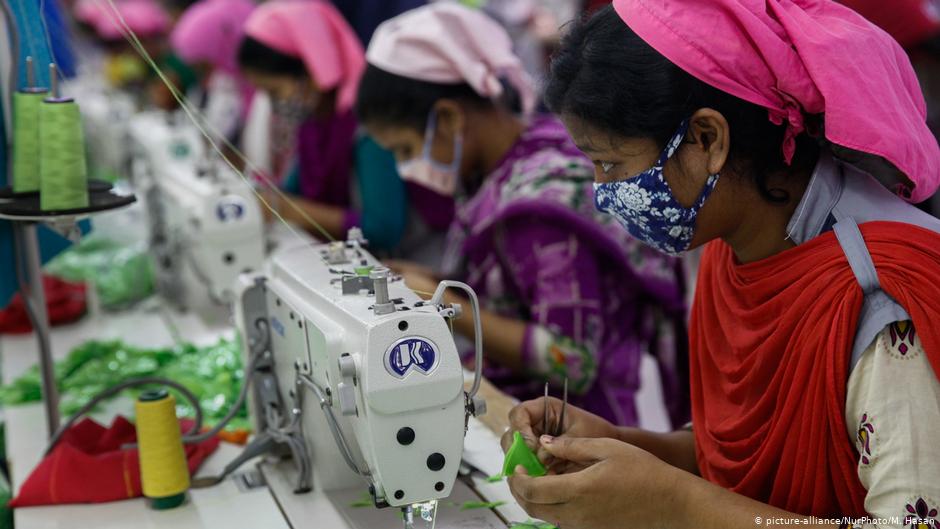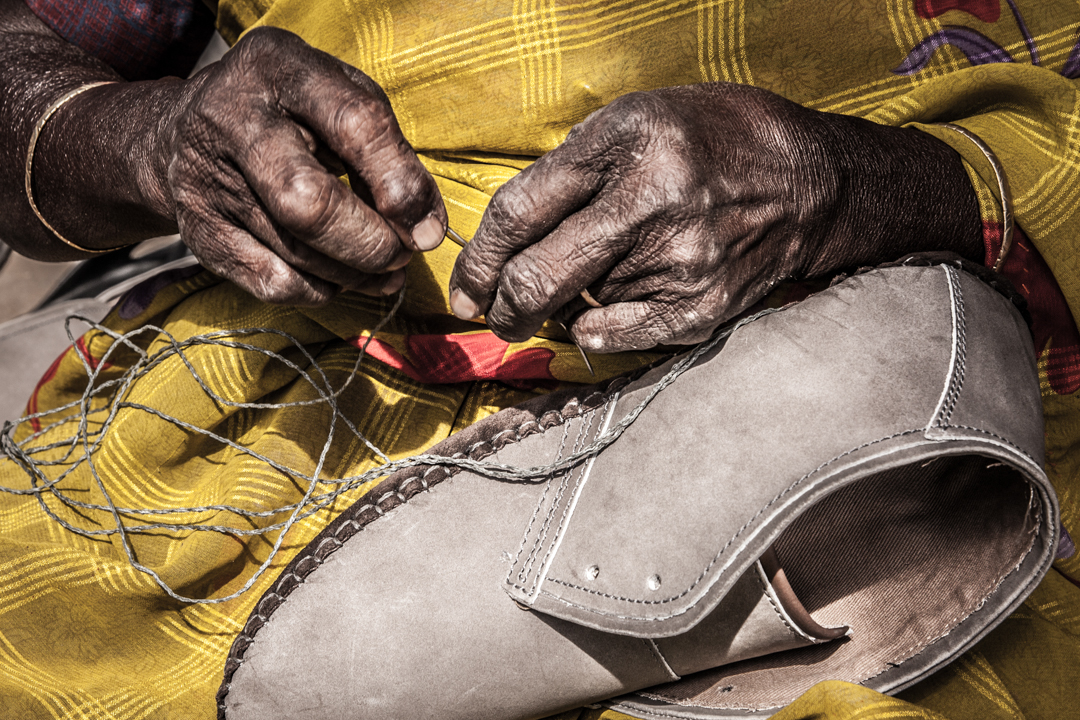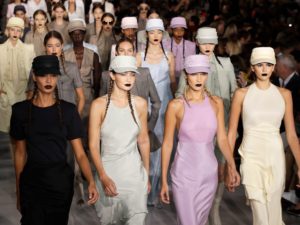It is, perhaps, as Marx and Engels observed: that capitalism inevitably sows its own seeds of destruction. In this case, not referring to consumption patterns hastening the Anthropocene, but to the inherent vulnerability found within fashion brands’ intentional construction of transnationally-fractured supply chains. Until COVID-19, marketing hid these fractures well. Very few consumers are aware of the journey and impacts a simple $20 cotton t-shirt makes: growing and harvesting its cotton, ginning and spinning its fibres, knitting or weaving its fabric, dying and processing it, cutting it, sewing it, packing and transporting it, and finally retailing it. All of which include a million little fractures and hidden jobs in between: seed sales, pesticides, farming equipment, transport, trade and price agreements, cotton sorting, and sub-sub-contracted dying, cutting, and sewing jobs.
This labour intensive project rarely occurs within the same cities or regions but runs zig-zag back and forth between countries (Green, 2015), interconnecting vast labour pools from which brands extract surplus. As many non-governmental organisations concerned with ethical and sustainable production have pointed out, it is almost impossible to trace the exact path of any given t-shirt. Cotton fibres themselves come from an assortment of countries (such as Uzbekistan, India, Turkey), and are then re-scattered to an assortment of countries for milling (like Pakistan, Mexico, China), then rerouted to be sewn in Vietnam, El Salvador, Bangladesh (Green, 2015). Transparency indexes show companies like the Gap list 50 countries where its suppliers are located; H&M deals with over 800 factories in Asia and Europe (Green, 2015).
These routes have not been constructed by corporate brands for physical efficiency. Clearly, they are far from it. Rather, this fracturing and relocation is a corporate search for cost efficiency – often along the path of least labour resistance – in order to find new spaces for capital investment and to make up for dwindling profits (Brooks, pp. 42-44). While cost avoidance is not a unique addition to neoliberalism (the Industrial Revolution already saw capitalists radically restructure cotton-manufacturing in ways beneficial to their bottom lines by utilizing space, machinery, and gender inequality in their favour)(Malm, pp. 67-69), the global freedom to reroute all facets of production to low-cost locales is. As the “free-trade” mantra of 1990s economists emerged alongside the technological advances of the internet, the repercussions of increased global trade and financial flows was a heavy blow to local – and previously tariff-protected – garment production (Brooks, p. 41).
The large swathes of post-WWII union-protected jobs that had defined US and European middle class prosperity from the 1940s to 1970s could then no longer compete under the new trade policies set in motion by Ronald Reagan and Margaret Thatcher in the 1980s; by the 1990s the influx of foreign garments made in factories by thousands of unprotected workers abroad collapsed well-paying and more slowly-produced garment sectors at home (Cline, pp. 37-41, 52). Rather than rethink the long-term effects of these flows, financial interests continued restructuring the global economy along neoliberalist ideological lines that demanded regulations hindering profits be removed. Western fashion brands simply abandoned European and North American labour (and labour standards) to relocate abroad and drive their production costs down to compete – often assisted by their own governments’ new anti-protectionist, anti-union policies (Cline, pp. 54-55).
While COVID-19 has forced the richer world to face the reality of just how precarious their own labour and living standards have become under socially-erosive policies, stagnant pay, and heightened living costs, these precarities have always been well-known to garment workers abroad, piled atop poverty wages, unsafe, and unsanitary workplaces. Reports coming in are beginning to paint a larger picture of what is happening within fashion’s supply chain as those at the top, again, try cut losses in order to remain competitive and “lean” in their production capacities. However, as Elizabeth Cline states, “clothing companies that do take advantage of lower labour costs inevitably ‘put pressure on those that do not, driving all to move towards this cost-cutting approach.'” Cheap, after all, “doesn’t just stay in its corner and play nicely by itself. It aggressively chases and kills off anything priced near it” (Cline, pp. 34, 54).
As Clean Clothes Campaign executive director Scott Nova said recently, “The fashion industry has evolved in a way that makes it hard in normal times for the people who actually make the clothes we wear every day to survive on the poverty wages they are paid” (Kelly, 2020). The fact that the clothes we wear every day rely on a sprawling interconnection of millions of unseen global workers means that disruptions in raw materials or consumption levels in one country closes factories and jobs in another. As of a few weeks ago, it was suggested that up to 10% of garment factories in Cambodia and Myanmar “are already closed, with workers not being paid their salaries”, with Turkey and Pakistan facing an “unmanageable level of unemployment” (Kelly, 2020; Clean Clothes Campaign, Live Blog).
Problematic is that some media coverage of COVID-19 is fixated on how it has affected the most glamourous aspects of fashion, such as COVID’s closure of the glitz of fashion weeks in Shanghai, Tokyo, Milan, and Moscow following February’s Paris, London, and New York weeks (Davis, 2020). Or how luxury brands are in a slump as their main consumers – Chinese buyers – stop shopping (Hanbury, 2020). The Met Gala for the crème-de-la-crème of celebs and designers is postponed, and odes to the Met Gala can be seen across Instagram (Tschorn, 2020). However, while top designers, celebs, and consumers suffer from momentary and individual losses of economic and social opportunity, garment workers’ losses are structured into their existence.
Many countries that revolve around a ready-made garment (RMG) industry already offer little or no social protections: poor health, poor nutrition, tight communal living quarters, and mass unemployment simply exacerbate the chances of COVID-19 devastation for these populations. Economic collapse for these populations doesn’t mean a CEO or shareholder loses millions – it equals death. Pakistan, despite being the 4th largest cotton exporter in the world, simply “cannot afford” to have its economy halted due to poverty: “if we save [people] from corona on the one side, on the other side they’ll die of hunger” (Al Jazeera, Pakistan PM). Bangladesh gains a vast majority of its export income on RMG (Ovi, 2019) due to its “comparative advantage” being cheap labour and reliable infrastructure. “Reliable” meaning that Bangladesh has the electricity, roads, and shipping ports necessary for exports…not necessarily fire escapes or structural integrity of factory walls.
This “comparative advantage” construction of international trade encouraged emerging economies to produce what they were most efficient at as a pathway to development. However, this has long been criticized by scholars who note that somehow the surplus generated for development keeps ending up in American and European pockets (McChesney, p. 3; Suwandi, pp. 17-19). If this is, as argued, a system constructed by those on top for those on top, it only makes sense that precarious labour and struggling countries are positioned to be the first to get the axe at the faintest hint of financial loss – COVID-19 or other. As is, the dominoes are already falling, but not just in these poorer countries.
Mark Zandi, chief economist at Moody’s Analytics, predicts four waves of economic hardship, the first two already underway: the global shuttering of productivity, and subsequent mass layoffs; the third and fourth waves occur at higher levels, when those with “nest eggs” see their savings wiped clean and who would have considered investment and expansion but are not able to do so. Last, institutions supporting the healthiest and strongest give way. Logically then, “absent a nationwide bailout…virtually every small, low-margin business that relies, in some way or another, on face-to-face interaction [will collapse]” (Klein, 2020). Small designers are, supposedly, at the heart of the neoliberalist “entrepreneurial” ideology and yet clearly they have been the first to die off and will continue to if not totally bailed out: they have the fragility of lacking savings and of being deemed “non-essential” under citywide closures. This, despite small brands’ overwhelming donations of hand-sewn, self-patterned facemasks and gowns to the gaping needs of a medical community underfunded by the state…and generally ignored by the corporate fashion behemoths most able to help in terms of production and fabric-sourcing capabilities.
The quandary is that this fractured, transnational system of fashion is clearly terrible, but so is its collapse. Will COVID-19’s closure of the global economy create an opportunity for better garment practices? Perhaps. At home and quarantined, average labourers in the richest countries are seriously questioning the lackluster quality of the social security promised them in exchange for all the productivity, taxes, and hours they’ve poured in. Apparently, working 40+ hours a week for an entire adult life only covers most of us for about two weeks before we find ourselves worrying about homelessness, hunger, and medical coverage.
This erosion of social protections combined with capitalism’s need to flow towards least-resistant (i.e., most desperate) labour has resulted in a tragic, full-circle irony: fashion firms are now fleeing rising wages abroad in traditionally exploited areas only to return to the union-gutted towns in America and Europe. Italy, once home to family business is now reliant upon the conglomerated luxury firms that comprise the backbone of its economy (Testa, 2020). This monopolistic inevitability of these titans of industry dampens the chance of any hopeful entrepreneurs (McChesney, p. 13), despite sustainability efforts relying on their small-and-slow approach.
Realistically, if Utopia is realized after COVID-19, it will be realized in the way consumers think about the flows within an economic system that failed to protect people. The normalcy of orientating socializing, energy, and time around consumption will have substantially subsided as possible months of further semi-isolation ensue. Social interactions and meagre provisions will have been rationed carefully. As in WWII where social norms around consumption were discouraged and products were rationed, there may emerge a “different economy” (Klein, 2020), one of an ideological shift away from prioritizing economic productivity and toward supporting well-being.
Countries’ crippled economies will shore up public support for locally-made products (as already dozens of Facebook posts have suggested) simply because local small businesses will have been those most active, helpful, and in tune with community needs. Perhaps too, there will be a dull weariness around the piles of useless products we spent months in quarantine with. A weariness at the twinges of boredom that nagged us to shop rather than phone a loved one. We will have watched each other struggle financially, physically, and emotionally as housing, health, and livelihoods collapsed. Maybe we will have less tolerance for the behemoth brands of the world. If privileged, we will have been forced away from thoughtless busy-ness into the solace of trees and books, and perhaps contemplated sustainability, birds, and silence for the first time. Perhaps these will start to feel normal. Just maybe it is at this point where precarious supply chains fall apart and where local talent and slow production can emerge – appreciated, and well-paid.
REFERENCES:
Al Jazeera. (2020, Mar. 18). Pakistan PM: ‘Cannot afford’ to shut down cities over coronavirus. Al Jazeera. Retrieved from https://www.aljazeera.com/news/2020/03/pakistan-pm-afford-shut-cities-coronavirus-200318065532802.html
Brooks, Andrew. (2015). Clothing Poverty: The Hidden World of Fast Fashion and Second-hand Clothes. London: UK, Zed Books.
Clean Clothes Campaign. (2020, Mar. 23). Live-blog: How the Coronavirus influences garment workers in supply chains. Clean Clothes Campaign. Retrieved from https://cleanclothes.org/news/2020/live-blog-on-how-the-coronavirus-influences-workers-in-supply-chains
Cline, Elizabeth L. (2013). Over-dressed: the Shockingly High Cost of Fast Fashion. NY: USA, Portfolio/Penguin Group.
Davis, Dominic-Madori. (2020, Mar. 17). Major luxury fashion houses are canceling or postponing shows amid the coronavirus outbreak. Business Insider. Retrieved from https://www.businessinsider.com/luxury-fashion-shows-events-canceled-amid-coronavirus-pandemic-2020-3
Goodman, Peter. S. (2016, Nov. 19).Italy’s banks are in a slow-motion crisis. Europe may pay. The New York Times. Retrieved from https://www.nytimes.com/2016/11/20/business/dealbook/italys-banks-are-in-a-slow-motion-crisis-and-europe-may-pay.html
Green, Matthew. (2015, Mar. 18). Where Does Your T-Shirt Come From? Follow Its Epic Global Journey. KQED. Retrieved from https://www.kqed.org/lowdown/7943/making-your-t-shirt-a-journey-around-the-world
Hanbury, Mary. (2020, Feb. 20). A former LVMH exec says the coronavirus outbreak is a ‘disaster’ for luxury brands as Chinese tourism evaporates. Business Insider. Retrieved from https://www.businessinsider.com/coronavirus-outbreak-disaster-for-lvmh-kering-2020-2
Kelly, Annie. (2020, Mar. 19). Garment workers face destitution as Covid-19 closes factories. The Guardian. Retrieved from https://www.theguardian.com/global-development/2020/mar/19/garment-workers-face-destitution-as-covid-19-closes-factories?fbclid=IwAR1QOKzfz-sSQej_ZzMNWY6PGBx4E19UNGy4OMUUmv3M3zpEFLCTSmzp34M
Klein, Ezra. (2020, Mar. 23). How the Covid-19 recession could become a depression. Vox. Retrieved from https://www.vox.com/2020/3/23/21188900/coronavirus-stock-market-recession-depression-trump-jobs-unemployment
Malm, Andreas. (2016). Fossil Capital. NY: USA, Verso Books.
McChesney, Robert. (2001). Global Media, Neoliberalism and Imperialism. Monthly Reivew, Vol. 52(10).
Ovi, Ibrahim Hossain. (2019, Jul. 4). Export posts 10.55% growth, RMG being 85% contributor. Dhaka Tribune. Retrieved from https://www.dhakatribune.com/business/2019/07/04/export-posts-10-55-growth-rmg-being-85-contributor
Suwandi, Intan. (2019). Value Chains: The New Economic Imperialism. NY: USA, Monthly Review Press
Testa, Jessica, Vanessa Friedman & Elizabeth Paton. (2020, Mar. 9). The Fashion World, Upended by Coronavirus. The New York Times. Retrieved from https://www.nytimes.com/2020/03/04/style/fashion-week-coronavirus-paris.html?action=click&module=RelatedLinks&pgtype=Article
Tschorn, Adam. (2020, Mar. 16). Coronavirus forces Met Gala Postponement, L.A. Fashion Week cancellations. Los Angeles Times. Retrieved from https://www.latimes.com/lifestyle/story/2020-03-16/covid-19-met-gala-los-angeles-fashion-week




